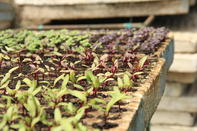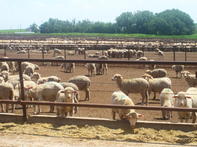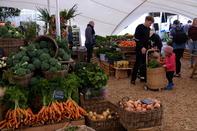Sustainable Diets
Every calorie of food we grow, harvest, ship, process, package, chill,cook, eat and throw away uses up resources from the environment: the soil and its nutrients, water, fertiliser, fuel, and so on. It also impacts on the environment by using its waste-absorbing systems:

fertiliser runoff pollutes our rivers, ploughing up land eats into grasslands and wetlands, and shunting carbon emissions into the air drive up temperatures and alter regional climate.
We need to think carefully about how we grow our food and what kinds of food we choose to eat if we want to tackle core issues of how sustainable our diets are.
Industrial-scale Farming

The industrial-scale farming of meat, dairy and poultry are not sustainable. It usually means animals are kept in confined feedlots and are raised on foods they’re not evolved to eat. Cows are grass eaters; chickens forage for seeds, bugs, worms, and the likes; pigs are omnivores.
Most of these animals are fed grain in the mass farming system. Not only is this diet unnatural for them, but growing grain for this purpose uses up land that could be used to grow a greater and more appropriate diversity of crops. The conversion rate of grain calories to meat calories is also very inefficient.
The scale of animal farming also has a considerable environmental impact in terms of transforming landscapes, water usage, and pollution in the form of greenhouse gases (mostly from burping ruminants and manure).
The animals often have to be dosed up heavily with antibiotics to avoid diseases common in such overcrowded conditions.
As communities become wealthier and more industrialised, we tend to increase our meat, dairy and egg consumption. This means the environmental footprint of our diet increases. The root of the problem is the industrial scale at which modern agriculture is trying to meet this growing need.
A Healthy Environment

It’s not about cutting out meat, dairy, and eggs completely but it’d about changing the way we farm the animals that provide us with important food, and how to eat more diverse diets. We need to do this for three reasons: it’s better for our health; it’s better for the health and well-being of the animals; it’s what South African soils are best equipped to do.
According to a WWF report on agriculture in South Africa, only one-third of the country’s soils (12% of the total area) are fertile enough for crop production, compared with 69% of the country that is suited to grazing. So it makes sense to rear livestock on the veld, which is a more ethical and environmentally sound way of rearing animals. As Tony Gerrans of Compassion in World Farming points out, these animals evolved roaming and grazing on the veld.
It’s also better for our heart health. In most of our food crops, the leaves are high in Omega 3 fatty acids, which we need a lot of; seeds are higher in Omega 6 fatty acids, which we need fewer of. Grass-fed animals, in turn, will have higher Omega 3s in their meat, milk, and eggs, while grain-fed animals have higher levels of Omega 6s. We need more O3s and fewer O6s in our diet for optimal heart health.
Power of the Consumer

The consumer has the power to change the market, merely by making certain choices:
Eat less meat. Try a meat-free Monday. Use meat to flavour food rather than as the main portion of the meals. Don’t be afraid of less conventional meat cuts and offal (a delicious soup made using bones gets the goodness of the marrow and ensures there is less wastage of the animal carcass, for instance).
Try to eat meat, dairy, and eggs from free-range and pasture-raised animals. This will encourage suppliers to stock ethical products while supporting ethical producers and encourage others to change their farming practices. In doing so we can work towards more accessible ethical sources on a larger scale so they are not only available to wealthy consumers.
Pay attention to product labelling.
Educate others.
Support local producers, especially small-scale and organic farmers, as well as informal traders selling fresh produce.